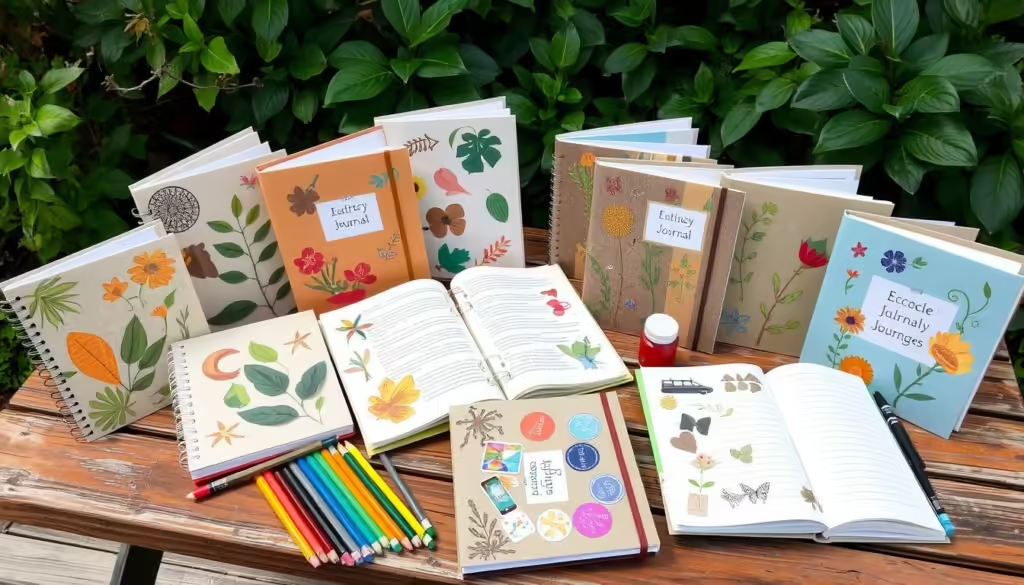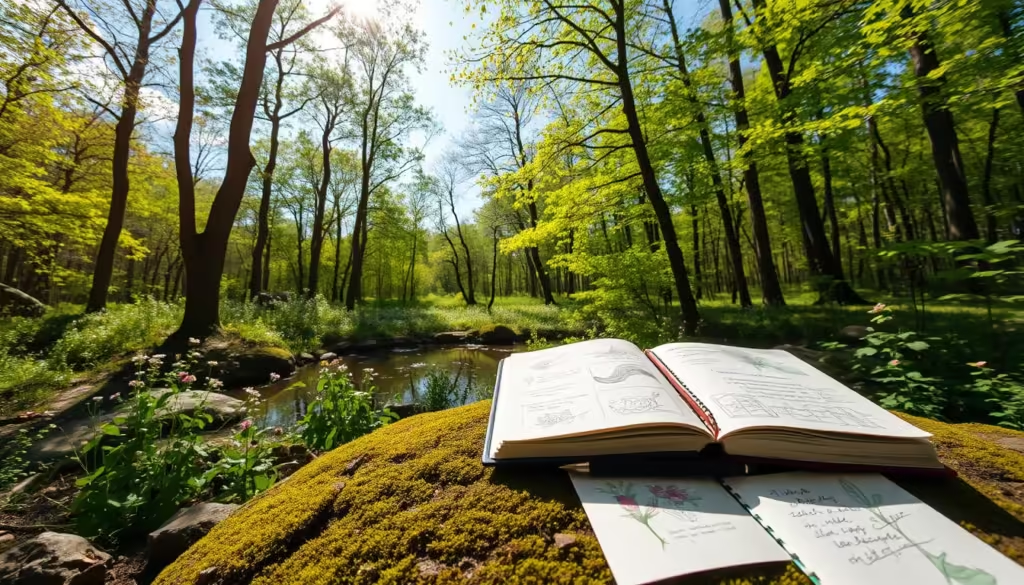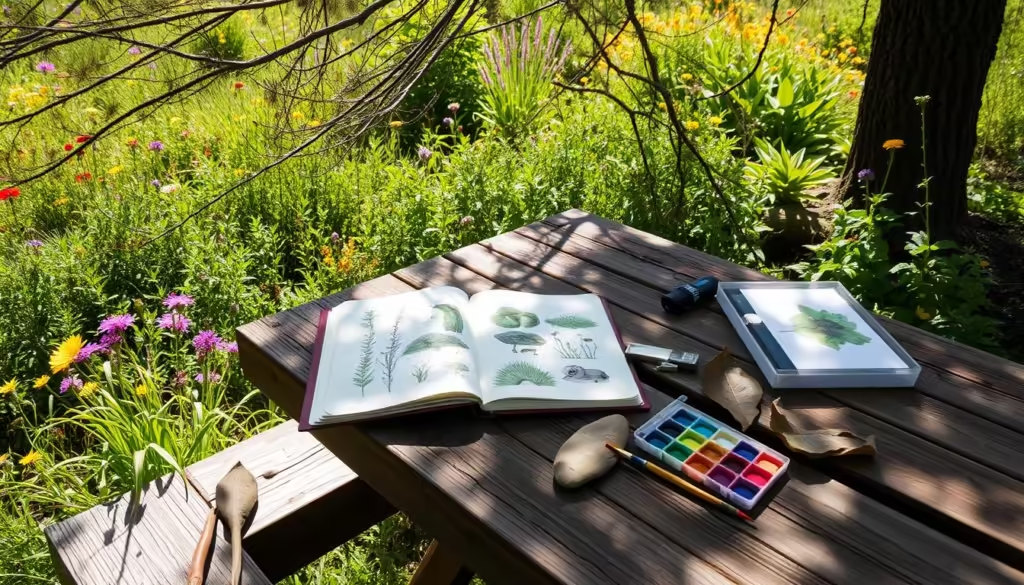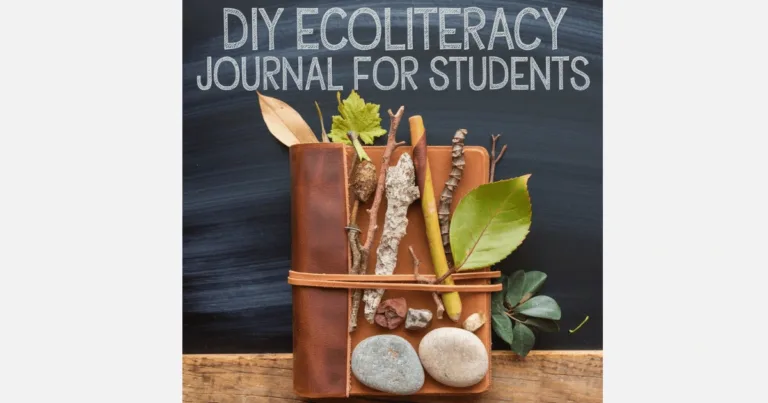
Table of Contents
As an educator, you know how vital it is to teach students about the environment. DIY ecoliteracy journals are a great way to do this. They let students express their creativity and connect with nature. We’ll look at five cool DIY ecoliteracy journal ideas that will excite your students and help them care more about the planet.

Key Takeaways
- Discover 5 fun and educational DIY ecoliteracy journal ideas for students
- Understand the purpose and benefits of creating an ecoliteracy journal
- Explore nature-inspired designs and upcycled materials for sustainable crafts
- Learn how to incorporate mindful observation and outdoor exploration into journaling
- Discover ways to foster environmental education and a green lifestyle through journaling
What is an Ecoliteracy Journal?
An ecoliteracy journal is a special kind of nature journal. It focuses on how we connect with the natural world. By using it, students learn more about ecosystems and develop eco-consciousness. They also learn to appreciate sustainable living.
Understanding the Purpose and Benefits
The main goal of an ecoliteracy journal is to help students notice, write down, and think about their environmental interactions. This can bring many benefits:
- Deeper environmental education and awareness
- Better connection to nature and its workings
- Stronger problem-solving and critical thinking skills
- Encouragement of green lifestyle habits and nature journaling skills
By writing down their experiences and thoughts, students gain a deeper understanding. They see how all living things are connected and their part in the eco-consciousness of our world.
“Keeping an ecoliteracy journal allows students to cultivate a profound appreciation for the natural world and their place within it.”
Nature journaling helps students explore their bond with the environment. They can find ways to live more sustainably. This way, they help make the world a greener place.
Unleash Creativity with Upcycled Materials
Creating an ecoliteracy journal is fun because you get to use sustainable materials. It helps reduce waste and makes students think creatively. They can turn old magazines into collages or cardboard boxes into sculptures.
Upcycling teaches students to see potential in everyday items. It shows them how to live sustainably and reduce waste. Crafting with upcycled materials lets students express themselves and feel proud of their work.
Using upcycled materials in your journal promotes green living and sparks imagination. You can make art from paper or turn plastic into useful items. It’s both educational and rewarding.
Start by collecting various materials from home or school. Magazines, newspapers, cardboard, fabric scraps, and old clothes can all be used. Encourage students to try collage, origami, or mixed media to make their creations stand out.
By focusing on eco-friendly crafts, you help students join the sustainability movement. It boosts their environmental awareness and creativity. This makes their ecoliteracy journal truly special.
diy ecoliteracy journal ideas
Creating your ecoliteracy journal is fun and fulfilling. Use nature-inspired designs to show your love for the environment. Add beautiful motifs that highlight nature’s wonders.
Here are some diy ecoliteracy journal ideas to try:
- Pressed flowers or leaves: Place delicate plants between your journal’s pages for a beautiful look.
- Botanical illustrations: Draw or paint colorful plants, trees, or animals to decorate inside.
- Recycled materials: Make unique covers and dividers from recycled paper, cardboard, or fabric.
- Collage elements: Cut out images, words, and patterns from magazines or newspapers for striking collages.
Adding nature-inspired designs to your journal strengthens your bond with nature and sustainable living. Let your imagination run wild as you make a journal that’s truly yours.
“The best way to find yourself is to lose yourself in the service of others.” – Mahatma Gandhi
Mindful Observation and Outdoor Exploration
Starting with nature journaling means learning to observe carefully. Students spend time outside, noticing the small details they usually miss. This helps them connect deeply with nature and understand how it works.
By exploring outdoors, students use all their senses. They see, hear, smell, and touch the world around them. Drawing, writing, and collecting things lets them feel closer to nature. This boosts their love for the environment and teaches them to care for it.
“The best way to find yourself is to lose yourself in the service of others.” – Mahatma Gandhi
When students journal about their outdoor adventures, they learn a lot. They start to see the world in a new way. This can make them want to help protect our planet for the future.

Nature journaling is a great way to teach students about the environment. It helps them see the world differently and want to make a difference. They become leaders in making our planet a better place.
Eco-Friendly Crafts for Sustainable Living
Embracing eco-friendly crafts is a great way to support sustainable living and cut down on waste. You can repurpose old items or create upcycled art projects. There are many creative ways to live sustainably every day.
Repurposing and Reducing Waste
Repurposing materials is a fantastic eco-friendly craft. You can turn old t-shirts into reusable bags or glass jars into stylish vases. The options are endless for giving new life to everyday items.
- Repurpose paper bags, magazines, or newspapers into unique gift wrapping or decorative elements.
- Upcycle plastic bottles or containers into planters, desk organizers, or even bird feeders.
- Craft stylish accessories like jewelry or keychains from reclaimed metals or discarded fabrics.
By doing these eco-friendly crafts, you can reduce waste and express your creativity. It helps you live a more sustainable life.
“Creativity is the power to connect the seemingly unconnected.” – William Plomer
Whether you’re a seasoned crafter or just starting, eco-friendly crafts are rewarding and impactful. So, why not dive into repurposing and upcycling today?
Environmental Education Through Journaling
Ecoliteracy journaling is a powerful tool for teaching about the environment. It helps students understand ecological issues better. They learn about topics like biodiversity, conservation, climate change, and sustainable living.
Nature journaling lets students see the natural world’s intricate patterns and connections. It makes them active in taking care of the environment. They learn to appreciate the balance of ecosystems.
Journaling helps students think about their lifestyle and its environmental impact. They record their observations and thoughts. This way, they learn about sustainable practices and how to use them in their daily lives.
Ecoliteracy journaling also boosts creativity and critical thinking. Students learn about environmental issues through their writing and sketches. This leads to new ideas and a stronger commitment to protecting the environment.
“Keeping an ecoliteracy journal allows students to not only learn about environmental topics but also to actively engage with and reflect on their own role in creating a more sustainable future.”
By using journaling in environmental education, teachers can make students more eco-conscious. This empowers them to be change-makers and advocates for sustainable living and green lifestyle.
| Key Benefits of Ecoliteracy Journaling | Outcomes |
|---|---|
| Deepens understanding of environmental issues | Increased knowledge and awareness of ecological topics |
| Encourages active engagement in environmental stewardship | Cultivates a sense of personal responsibility and a desire to protect the environment |
| Promotes critical thinking and problem-solving skills | Develops innovative solutions to environmental challenges |
| Inspires creativity and self-expression | Fosters a deeper connection with nature and a love for environmental education |
Fostering a Green Lifestyle
Ecoliteracy journaling helps students see the world in a new light. It makes them care more about the environment. They learn to make choices that help protect our planet.
Cultivating Eco-Consciousness
Through journaling, students think about how they affect the earth. They start to find ways to live greener. This might mean:
- Reducing waste and recycling regularly
- Choosing products that are good for the planet
- Using less energy at home and school
- Buying food that’s good for the earth
- Helping out in nature and conservation
As they grow more aware, they can share their knowledge with others. This can make a big difference. It helps everyone live in a way that’s better for our planet.
| Sustainable Practice | Environmental Impact | Personal Benefits |
|---|---|---|
| Recycling | Reduces waste, conserves natural resources | Teaches responsibility, saves money, promotes eco-consciousness |
| Switching to renewable energy | Reduces greenhouse gas emissions, supports clean energy | Saves money on utilities, contributes to a sustainable future |
| Buying local and organic food | Reduces carbon footprint, supports local economy | Promotes healthier eating, supports small businesses |
By taking part in ecoliteracy journaling, students can make a real difference. They inspire others to care for the earth. Together, they can create a greener future.
Engaging Students with Nature Journaling
Teaching students to love nature is key to raising eco-conscious kids. Nature journaling is a fun way to spark their curiosity and help them understand the environment better.
Nature journaling gets students to explore and observe the outdoors. It’s not just about learning; it’s about connecting with nature. This practice helps students care more about the planet.
- Enhance observational skills: Nature journaling teaches students to notice the small details of nature, like plants and animals.
- Cultivate creativity: By recording and sketching their experiences, students can express their creativity and share their outdoor adventures.
- Promote scientific inquiry: Students can turn their journaling into science by asking questions and documenting their discoveries.
- Develop eco-consciousness: Through journaling, students learn to appreciate nature and think about how their actions affect the environment.
Adding nature journaling to school curricula can make students love nature more. It lets them explore, observe, and record their outdoor experiences. This way, teachers can help raise a generation that cares about the planet.

| Benefits of Nature Journaling | Key Outcomes |
|---|---|
| Enhances observational skills | Improved attention to detail and understanding of natural systems |
| Cultivates creativity | Encourages self-expression and personal connection with the environment |
| Promotes scientific inquiry | Fosters critical thinking, hypothesis-testing, and data collection |
| Develops eco-consciousness | Instills a sense of stewardship and commitment to sustainable practices |
“Nature journaling is a powerful tool for engaging students in the wonders of the natural world and inspiring them to become active stewards of the environment.”
Tips for Inspiring Ecoliteracy in the Classroom
Teaching environmental education in the classroom is key for a green future. Nature journaling and ecoliteracy projects are great ways to engage students. They help students see the beauty of nature and value environmental protection.
Here are some tips to inspire ecoliteracy in the classroom:
- Share Inspirational Examples: Show students nature-inspired designs and eco-friendly crafts. This sparks their creativity and interest in living sustainably.
- Organize Outdoor Exploration: Plan field trips or outdoor activities. This lets students observe and interact with nature, building a connection with the world.
- Encourage Sustainable Practices: Teach students eco-friendly habits like recycling and composting. Encourage them to apply these in their daily lives.
- Integrate Environmental Education: Mix environmental education into different subjects. This shows students why conservation and sustainable living are crucial.
- Promote Nature Journaling: Encourage students to keep nature journals. They can record observations, sketches, and thoughts about nature.
By using these strategies, teachers can inspire students to care for the environment. Through nature journaling and exploring green lifestyles, students learn to appreciate nature. They also commit to a sustainable future.
“Educating the mind without educating the heart is no education at all.” – Aristotle
Conclusion
Your ecoliteracy journal has been a journey of growth. It has helped you connect more deeply with nature and live sustainably. You’ve used creative materials, observed nature mindfully, and made eco-friendly projects. This has made you appreciate the environment and your role in protecting it.
Your nature journaling has given you insights into environmental issues. This has made you more aware and inspired you to make green choices. The skills and knowledge you’ve gained will help you and inspire others to care for the environment.
Keep exploring and creating with sustainable practices in your life. Your ecoliteracy journal shows your dedication to a greener future. Keep inspiring others to join you in protecting our planet.
FAQ
What is an ecoliteracy journal?
An ecoliteracy journal is a special kind of nature journal. It focuses on your connection with the natural world. It helps you understand ecosystems better and appreciate sustainable living.
What are the benefits of creating an ecoliteracy journal?
An ecoliteracy journal deepens your bond with nature. It also boosts your environmental knowledge. It encourages you to live more eco-friendly.
How can I use upcycled materials to create an ecoliteracy journal?
Use sustainable, upcycled materials for your journal. This reduces waste and sparks creativity. It turns everyday items into unique, eco-friendly crafts.
What kind of nature-inspired designs can I incorporate into my ecoliteracy journal?
Designing your journal can be fun. Add nature-inspired motifs like leaves or flowers. This reflects your love for the environment.
How can mindful observation and outdoor exploration enhance my ecoliteracy journaling experience?
Mindful observation is key. Spend time in nature to observe closely. This deepens your connection to the environment.
What are some eco-friendly crafts I can create to complement my ecoliteracy journal?
Create eco-friendly crafts to go with your journal. Use recycled paper or upcycled materials. This promotes sustainable living.
How can ecoliteracy journaling contribute to environmental education?
Ecoliteracy journaling enhances your environmental knowledge. It teaches you about sustainable practices. It empowers you to care for the environment.
How can ecoliteracy journaling help me cultivate a green lifestyle?
Journaling inspires a green lifestyle. It deepens your appreciation for nature. This leads to making eco-friendly choices.
How can nature journaling engage students in ecoliteracy and environmental education?
Nature journaling engages students in ecoliteracy. It encourages them to observe and record nature. This builds a strong connection to the environment.
How can educators inspire ecoliteracy in the classroom through journaling?
Educators can inspire ecoliteracy through journaling. Share examples and organize outdoor activities. Encourage sustainable living and eco-friendly crafts.

